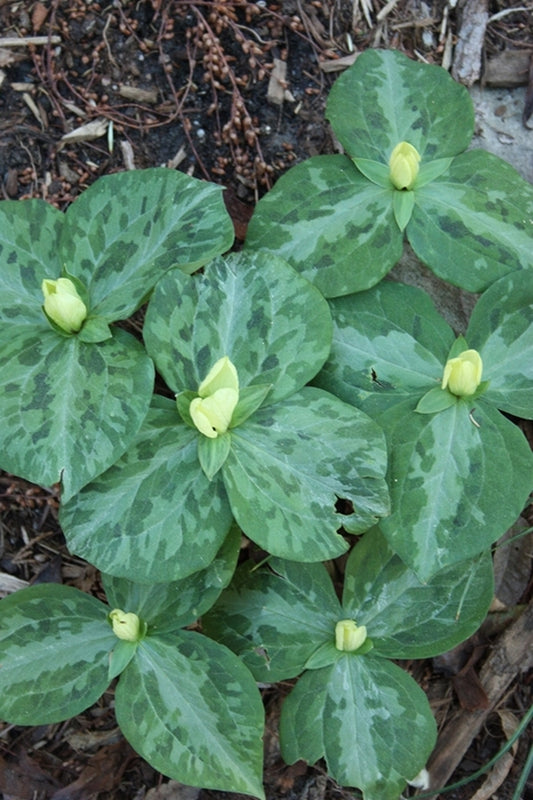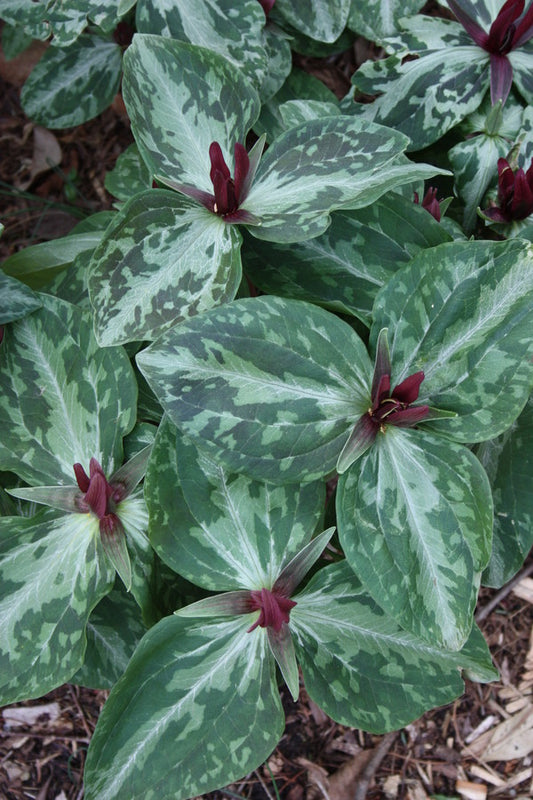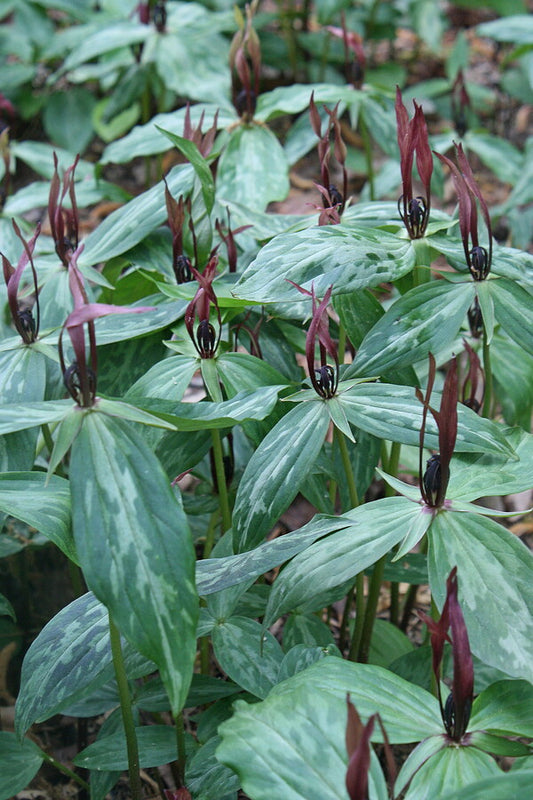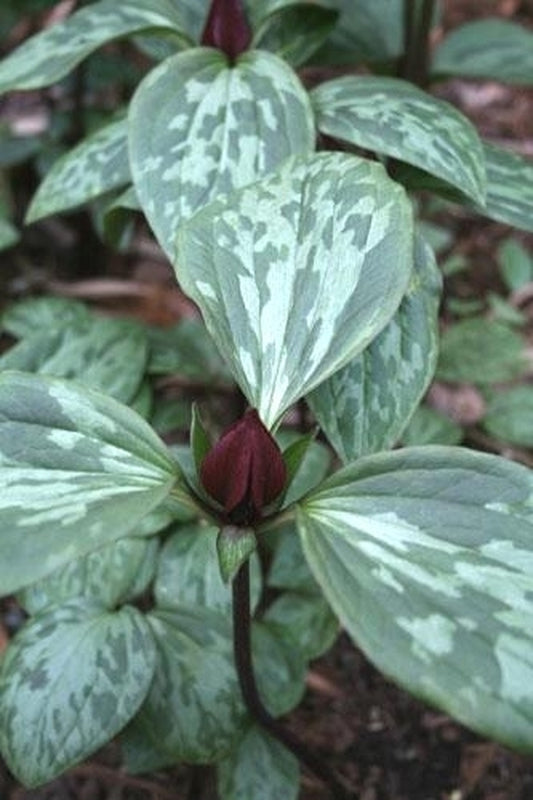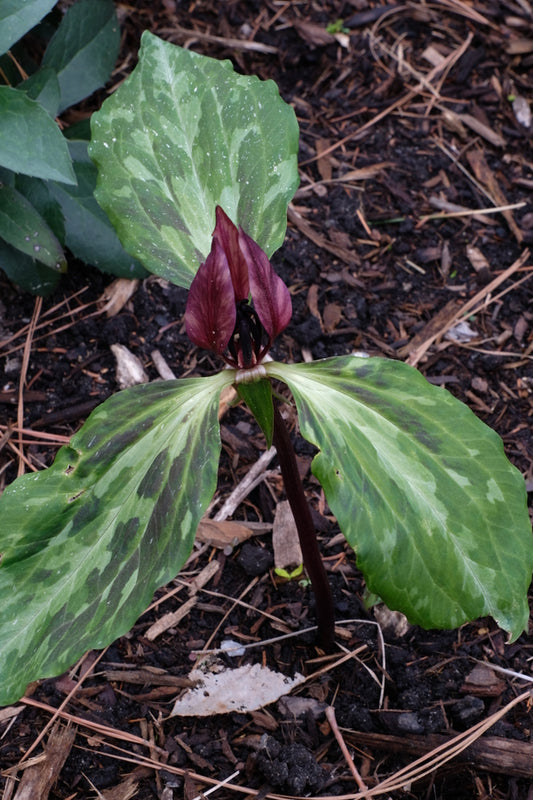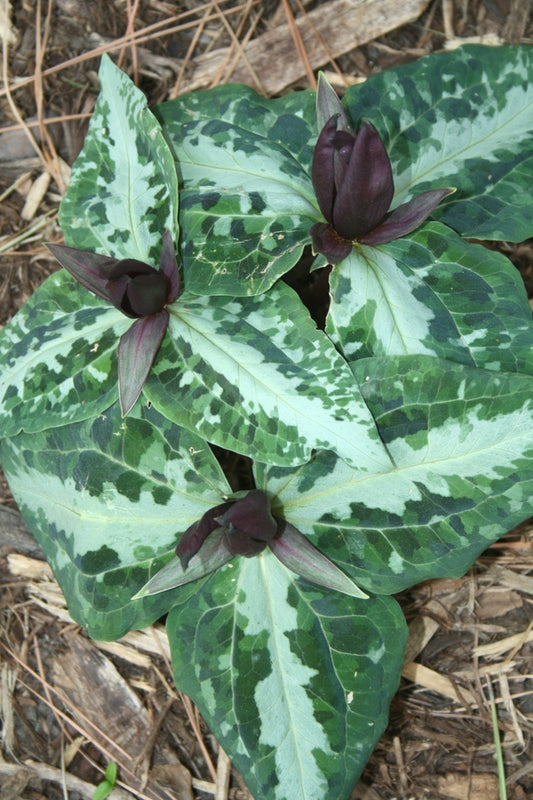Trilliums are easy to grow, preferring light shade and a compost amended garden soil. Plant Delights has one of the largest Trillium collections of in the world. As more and more of our nursery seed-propagated trilliums reach flowering size, our offering of these great native perennials continues to expand. We now have nearly 10,000 plants in production, encompassing a range of Southeast US native species. These easy-to-grow, spring ephemerals are a worldwide favorite, and they seem to exude a magical feeling when they blossom in the woodland garden.
-
Trillium discolor
Item #: 11799
Zones: 5a to 8b, guessing
Dormancy: Summer, Fall
Height: 6" tall
Culture: Light Shade
Origin: United States
Pot Size: 3.5" pot (24 fl. oz/0.7 L)
Regular price $39.00Regular priceUnit price per -
Trillium foetidissimum 'Baton Rouge'
Item #: 7103
Zones: 5a to 9b, at least
Dormancy: Summer, Fall
Height: 10" tall
Culture: Light Shade
Origin: United States
Pot Size: 3.5" pot (24 fl. oz/0.7 L)
Regular price $30.00Regular priceUnit price per -
Trillium lancifolium 'Close Knit Family'
Item #: 18682
Zones: 6a to 9b, possibly colder
Dormancy: Summer, Fall
Height: 10" tall
Culture: Light Shade
Origin: United States Hybrid
Pot Size: 3.5" pot (24 fl. oz/0.7 L)
Regular price $30.00Regular priceUnit price per -
Trillium lancifolium 'Shotgun Wedding'
Item #: 1465
Zones: 6a to 9b, possibly colder
Dormancy: Summer, Fall
Height: 10" tall
Culture: Light Shade
Origin: United States Hybrid
Pot Size: 3.5" pot (24 fl. oz/0.7 L)
Regular price $28.00Regular priceUnit price per -
Trillium oostingii
Item #: 11723
Zones: 6a to 9b, at least
Dormancy: Summer, Fall
Height: 8" tall
Culture: Light Shade
Origin: United States
Pot Size: 3.5" pot (24 fl. oz/0.7 L)
Regular price $40.00Regular priceUnit price per -
Trillium recurvatum 'Arcadia'
Item #: 8684
Zones: 5a to 9b
Dormancy: Summer, Fall
Height: 18" tall
Culture: Light Shade
Origin: United States
Pot Size: 3.5" pot (24 fl. oz/0.7 L)
Regular price $30.00Regular priceUnit price per -
Trillium x recurvifolium 'Love Shack'
Item #: 16645
Zones: 5a to 9b
Dormancy: Summer, Fall
Height: 12" tall
Culture: Light Shade
Origin: United States Hybrid
Pot Size: 3.5" pot (24 fl. oz/0.7 L)
Regular price $30.00Regular priceUnit price per -
Trillium underwoodii
Item #: 2973
Zones: 6a to 9b
Dormancy: Summer, Fall
Height: 8" tall
Culture: Part Sun to Light Shade
Origin: United States
Pot Size: 3.5" pot (24 fl. oz/0.7 L)
Regular price $37.00Regular priceUnit price per
More Information About Trillium
Growing Trillium
Despite myths to the contrary, trillium are easy-to-grow woodland perennials, preferring light shade and a compost amended garden soil. Trilliums are spring ephemeral perennials, whose yearly life cycle is compressed into a short 6-8 week period in late winter or early spring before the trees leaf out. Trillium's ephemeral life cycle does not mean that they have a small impact in the woodland garden. Quite the opposite. The lovely variegated leaves, and three-petalled flowers of trilliums leaves an impression that lasts for the rest of the year.
Propagating Trillium
Plant Delights Nursery has one of the largest trillium plant propagation programs in the world. As more and more of our nursery seed-propagated trillium selections reach flowering size, we are able to offer this beautiful genus to you at our Raleigh, NC facility. We now have nearly 10,000 trillium plants in production, encompassing a range of Southeast US native species, with a special focus on sessile trillium species including the popular Trillium discolor.
The Trillium business is a tough one to be in as Trillium plants generally take from 4 to 7 years from seed to produce a flowering-size plant, and with a production cycle that long, Trillium nurseries are rare. But we love trilliums and take the time to sustainably propagate them for you. Our trilliums are environmentally sustainable and eco-friendly as we do not dig wild specimens to sell but instead sustainably propagate our trilliums from seed.
Trillium Morphology
Trilliums have an interesting anatomy....the 3 inch leaves that give trillium plants their characteristic form are actually bracts. The true leaves are greatly reduced structures that surround the underground rhizome. Trillium seeds are also fascinating...they are attached to a nutritious structure called an elaiosome that insects love to eat. When trillium seeds are ripe, ants and wasps carry them to their nests where they consume the elaiosome and leave the seed to germinate...a horticultural win-win situation.
Sessile and Pedicel Trillium
There are many trillium lower classifications but for gardeners, trilliums are divided into two main groups...the sessile trilliums whose flower sits on top of the leaf, and the pedicellate trilliums, whose flower is attached to the leaf by a short stem (pedicel). One common American native trillium, Trillium sessile is even named for this floral trait.
Other Resources:
- Check out our Trillium photo gallery at JLBG.org.
- Listen to Tony Avent talk about trilliums on the A Way to Garden Podcast.
- Check out our many blog posts about trilliums.
- Watch our trillium videos below or read the transcripts here and here.


